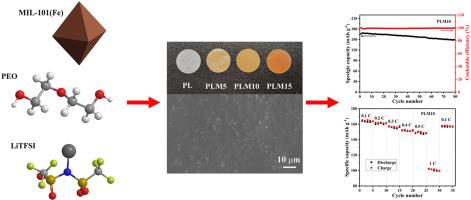金属-有机框架(MIL-101Fe) -用于所有固态锂离子电池的复合聚合物电解质
IF 7.9
2区 工程技术
Q1 CHEMISTRY, PHYSICAL
引用次数: 0
摘要
固体聚合物电解质成为所有固态锂电池(ASSLBs)的有吸引力的候选者。然而,离子电导率低和机械性能差的缺点阻碍了其商业化应用。本文将金属有机骨架(MOFs)引入聚氧化物(PEO)中,制备用于asslb的复合聚合物电解质(cpe)。具有多孔结构的MIL-101(Fe)有效降低了玻璃化转变温度,限制了PEO阴离子的迁移,使其具有较高的Li+迁移数(0.47),在80℃时离子电导率显著提高,达到4.78 × 10−3 S cm−1。此外,添加10 wt% MIL-101(Fe)的CPE具有更宽的电化学稳定窗口(5.25 V),提高了380°C的热稳定性,提高了0.62 MPa的拉伸强度。固态LiFePO4|锂电池在0.1C和50°C下的放电容量为16a5.49 mAh g - 1,经过80次循环后容量保持率为87.9%。在0.5C和50°C的高电流下循环80次后,电池的容量保持率为93.8%。这些结果表明MIL-101(Fe) - PEO是一种很有前途的安全、长寿命电池固体电解质。本文章由计算机程序翻译,如有差异,请以英文原文为准。

Metal-organic framework (MIL-101Fe) - incorporated composite polymer electrolytes for all solid-state lithium-ion batteries
Solid polymer electrolyte emerges as an attractive candidate for all solid-state lithium batteries (ASSLBs). Nevertheless, the drawbacks of low ionic conductivity and poor mechanical property hinder the commercial application. Herein, the metal-organic framework (MOFs) is introduced into polyethylene oxide (PEO) to produce composite polymer electrolytes (CPEs) for ASSLBs. It is disclosed that the MIL-101(Fe) with porous structure effectively lowers glass transition temperature, and restricts the migration of anions of PEO, resulting in high Li+ transference number (0.47) and the significantly improved ionic conductivities of 4.78 × 10−3 S cm−1 at 80 °C. Moreover, the CPE with 10 wt% MIL-101(Fe) exhibits a widened electrochemical stability window (5.25 V), enhanced thermal stability to 380 °C and improved tensile strength of 0.62 MPa. The solid-state LiFePO4|10 wt% MOF/PEO|Li battery delivers an improved discharge capacity of 16a5.49 mAh g−1 at 0.1C and 50 °C with a capacity retention of 87.9 % after 80 cycles. After cycling at a high current of 0.5C and 50 °C for 80 cycles, the battery delivers a capacity retention of 93.8 %. These results demonstrate that MIL-101(Fe) - incorporated PEO is a promising solid electrolyte for safe and long-life batteries.
求助全文
通过发布文献求助,成功后即可免费获取论文全文。
去求助
来源期刊

Journal of Power Sources
工程技术-电化学
CiteScore
16.40
自引率
6.50%
发文量
1249
审稿时长
36 days
期刊介绍:
The Journal of Power Sources is a publication catering to researchers and technologists interested in various aspects of the science, technology, and applications of electrochemical power sources. It covers original research and reviews on primary and secondary batteries, fuel cells, supercapacitors, and photo-electrochemical cells.
Topics considered include the research, development and applications of nanomaterials and novel componentry for these devices. Examples of applications of these electrochemical power sources include:
• Portable electronics
• Electric and Hybrid Electric Vehicles
• Uninterruptible Power Supply (UPS) systems
• Storage of renewable energy
• Satellites and deep space probes
• Boats and ships, drones and aircrafts
• Wearable energy storage systems
 求助内容:
求助内容: 应助结果提醒方式:
应助结果提醒方式:


